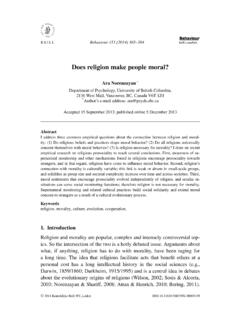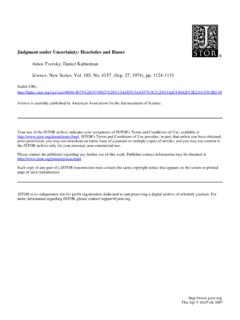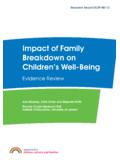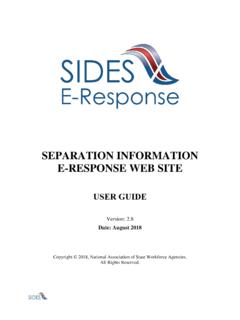Transcription of Romantic Love Conceptualized as an Attachment Process
1 Romantic Love Conceptualized as an Attachment Process Cindy Hazan and Phillip Shaver University of Denver This article explores the possibility that Romantic love is an Attachment Process --a biosocial Process by which affectional bonds are formed between adult lovers, just as affectional bonds are formed earlier in life between human infants and their parents. Key components of Attachment theory, developed by Bowlby, Ainsworth, and others to explain the development of affectional bonds in infancy, were translated into terms appropriate to adult Romantic love. The translation centered on the three major styles of Attachment in infancy--secure, avoidant, and anxious/ambivalent--and on the notion that continuity of relationship style is due in part to mental models (Bowlby's "inner working models") of self and social life.
2 These models, and hence a person's Attachment style, are seen as determined in part by childhood relationships with parents. Two questionnaire studies indi- cated that (a) relative prevalence of the three Attachment styles is roughly the same in adulthood as in infancy, (b) the three kinds of adults differ predictably in the way they experience Romantic love, and (c) Attachment style is related in theoretically meaningful ways to mental models of self and social relationships and to relationship experiences with parents. Implications for theories of Romantic love are discussed, as are measurement problems and other issues related to future tests of the Attachment perspective. One of the landmarks of contemporary psychology is Bowl- by's (1969, 1973, 1980) three-volume exploration of attach- ment, separation , and loss, the processes by which affectional bonds are forged and broken.
3 Bowlby's major purpose was to describe and explain how infants become emotionally attached to their primary caregivers and emotionally distressed when separated from them, although he also contended that "attach- ment behavior [characterizes] human beings from the cradle to the grave" (1979, p. 129). In recent years, laboratory and naturalistic studies of infants and children (summarized by Bretherton, 1985, and Maccoby, 1980) have provided consider- able support for Attachment theory, which was proposed by Bowlby and elaborated by several other investigators. The pur- pose of this article is to explore the possibility that this theory, designed primarily with infants in mind, offers a valuable per- spective on adult Romantic love. We will suggest that Romantic love is an Attachment Process (a Process of becoming attached), We are grateful to Donna Bradshaw for sharing her expertise in the areas of Attachment theory and research, to Marry Meitus for allowing us to conduct Study 1 in the Rocky Mountain News, to Kathy Purcell for keypunching, to Rick Canfield for assistance in all phases of the project, and to Mary Ainsworth, John Bowlby, Harry Gollob, Lee Kirk- patrick, Roger Kobak, Anne Peplau, Harry Reis, Judith Schwartz, Ar- lene Skolnick, and Robert Sternberg for helpful comments on conven- tion presentations and earlier drafts of this article.
4 Correspondence concerning this article should be addressed to Cindy Hazan or to Phillip Shaver, Department of Psychology, University of Denver, Denver, Colorado 80208-0204. experienced somewhat differently by different people because of variations in their Attachment histories. For our purpose, which is to create a coherent framework for understanding love, loneliness, and grief at different points in the life cycle, Attachment theory has several advantages over ex- isting approaches to love (Shaver, Hazan, & Bradshaw, in press). First, although many researchers ( , Rubin, 1973; Hatfield & Sprecher, 1985) have attempted to assess love with unidimen- sional scales, love appears to take multiple forms ( , Dion & Dion, 1985; Hendrick & Hendrick, 1986; Lee, 1973; Stock, Levitan, McLane, & Kelley, 1982; Sternberg, 1986; Tennov, 1979).
5 Attachment theory explains how at least some of these forms develop and how the same underlying dynamics, com- mon to all people, can be shaped by social experience to pro- duce different relationship styles. Second, although various au- thors have portrayed certain forms of love as healthy and others as unhealthy, or at least problematic ( , Hindy & Schwarz, 1984; Tennov, 1979), they have not said how the healthy and unhealthy forms fit together in a single conceptual framework. Attachment theory not only provides such a framework, but it also explains how both healthy and unhealthy forms of love originate as reasonable adaptations to specific social circum- stances. The portrait of love offered by Attachment theory in- cludes negative as well as positive emotions: for example, fear of intimacy (discussed by Hatlield, 1984), jealousy ( , Hindy & Schwarz, 1985), and emotional ups and downs (Tennov, 1979) as well as caring (Rubin, 1973), intimacy (Sternberg, 1986), and trust (Dion & Dion, 1985).
6 Third, Attachment the- ory deals with separation and loss and helps explain how loneli- ness and love are related (Shaver & Rubenstein, 1980; Parkes & Journal of Personality and Social Psychology, 1987, Vol. 52, No. 3, 511-524 Colwfight 1987 by the American Psychological Association, Inc. 0022-3514/87/$ 511 512 CINDY HAZAN AND PHILLIP SHAVER Weiss, 1983; Weiss, 1973). Finally, Attachment theory links adult love with socioemotional processes evident in children and nonhuman primates; it places love within an evolutionary context (Wilson, 1981). (See Sternberg & Barnes, in press, for an anthology of recent approaches to the study of adult love.) Attachment Theory and Research Bowlby's Attachment theory grew out of observations of the behavior of infants and young children who were separated from their primary caregiver (usually the mother) for various lengths of time.
7 Bowlby noticed what primate researchers had also observed in the laboratory and the field: When a human or primate infant is separated from its mother, the infant goes through a predictable series of emotional reactions. The first is protest, which involves crying, active searching, and resistance to others' soothing efforts. The second is despair, which is a state of passivity and obvious sadness. And the third, discussed only with reference to humans, is detachment, an active, seemingly defensive disregard for and avoidance of the mother if she re- turns. Because of the remarkable similarities between human infants and other primate infants, Bowlby was led to consider the evolutionary significance of infant--careglver Attachment and its maintenance in the face of separation . The Attachment system, as Bowlby called the complex con- stellation of Attachment feelings and behaviors, seems to have evolved to protect infants from danger by keeping them close to the mother.
8 When very young, a human infant can do little more than cry, make eye contact, smile, and snuggle in to en- courage its mother to keep it near. Once mobile, however, it can actively pursue its mother and vocalize to her. Bowlby and other observers of both human and primate behavior have noticed that when an infant is healthy, alert, unafraid, and in the pres- ence of its mother, it seems interested in exploring and master- ing the environment and in establishing aifiliative contact with other family and community members. Researchers call this us- ing the mother as a secure base. Attachment theory can be summarized in three propositions, phrased clearly in the second volume of Bowlby's trilogy: The first [proposition] is that when an individual is confident that an Attachment figure will be available to him whenever he desires it, that person will be much less prone to either intense or chronic fear than will an individual who for any reason has no such confi- dence.
9 The second proposition concerns the sensitive period during which such confidence develops. It postulates that confidence in the availability of Attachment figures, or lack of it, is built up slowly during the years of immaturity--infancy, childhood, and adoles- cence-and that wliatever expectations are developed during those years tend to persist relatively unchanged throughout the rest of life. The third proposition concerns the role of actual experience. It postulates that the varied expectation'g of the accessibility and responsiveness of Attachment figures that individuals develop dur- ing the years of immaturity are tolerably accurate reflections of the experiences those individuals have actually had. (Bowlby, 1973, p. 235) The formation during early childhood of a smoothly func- tioning ( , secure) Attachment relationship with a primary caregiver, although the norm in our society, is by no means guaranteed.
10 Research by Ainsworth and others suggests that a mother's sensitivity and responsiveness to her infant's signals and needs during the first year of life are important prerequi- sites. Mothers who are slow or inconsistent in responding to their infant's cries or who regularly intrude on or interfere with their infant's desired activities (sometimes to force affection on the infant at a particular moment) produce infants who cry more than usual, explore less than usual (even in the mother's presence), mingle Attachment behaviors with overt expressions of anger, and seem generally anxious. If, instead, the mother consistently rebuffs or rejects the infant's attempts to establish physical contact, the infant may learn to avoid her. On the basis of their observations, Ainsworth, Blehar, Waters, and Wall (1978) delineated three styles or types of Attachment , often called secure, anxious/ambivalent, and avoidant.
















